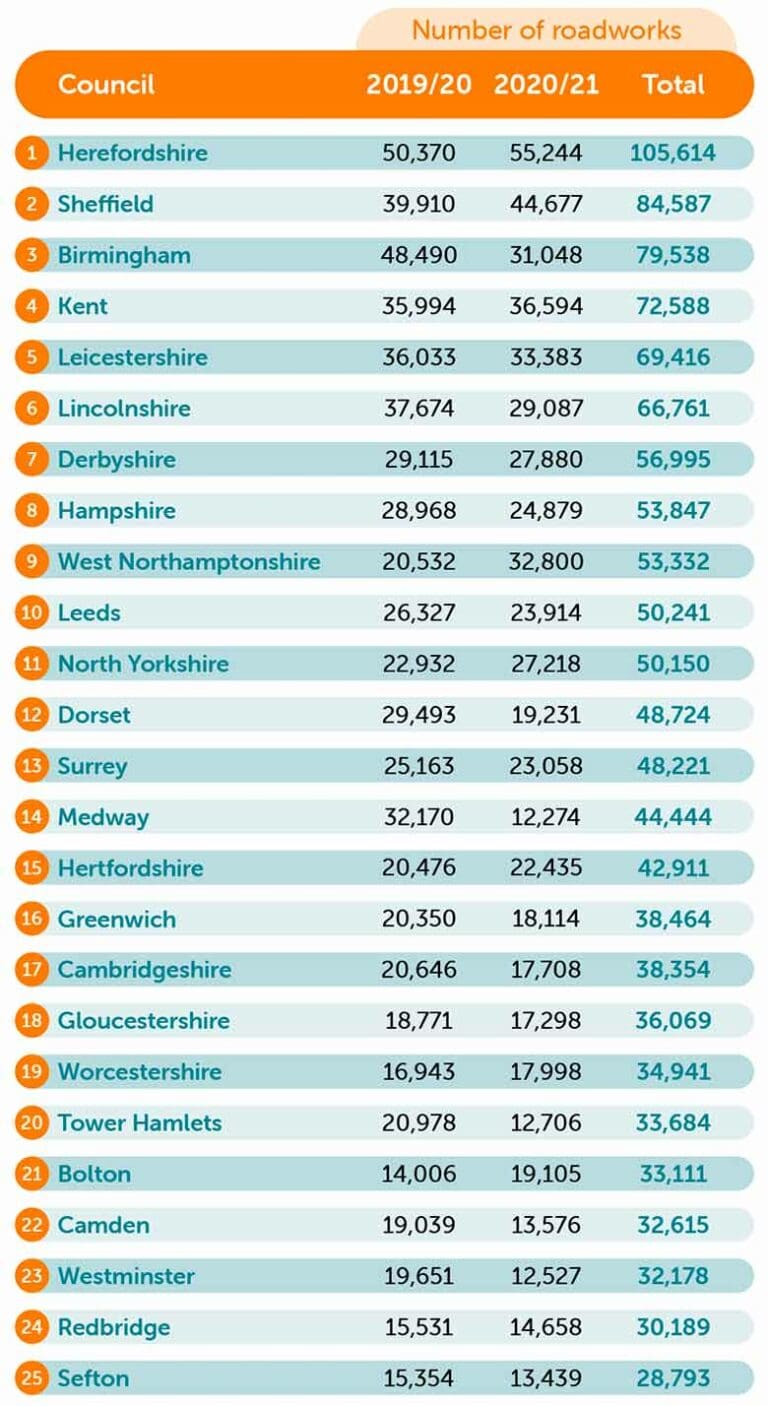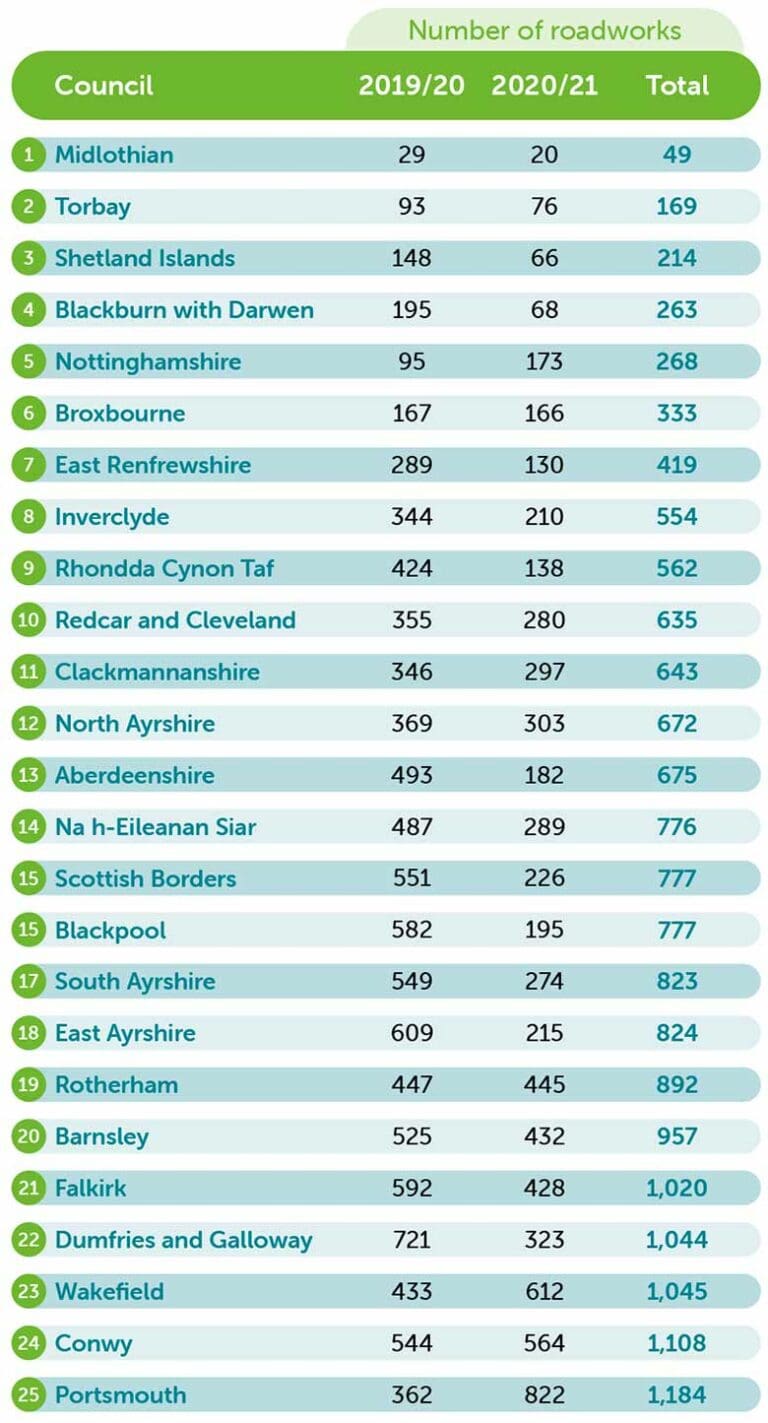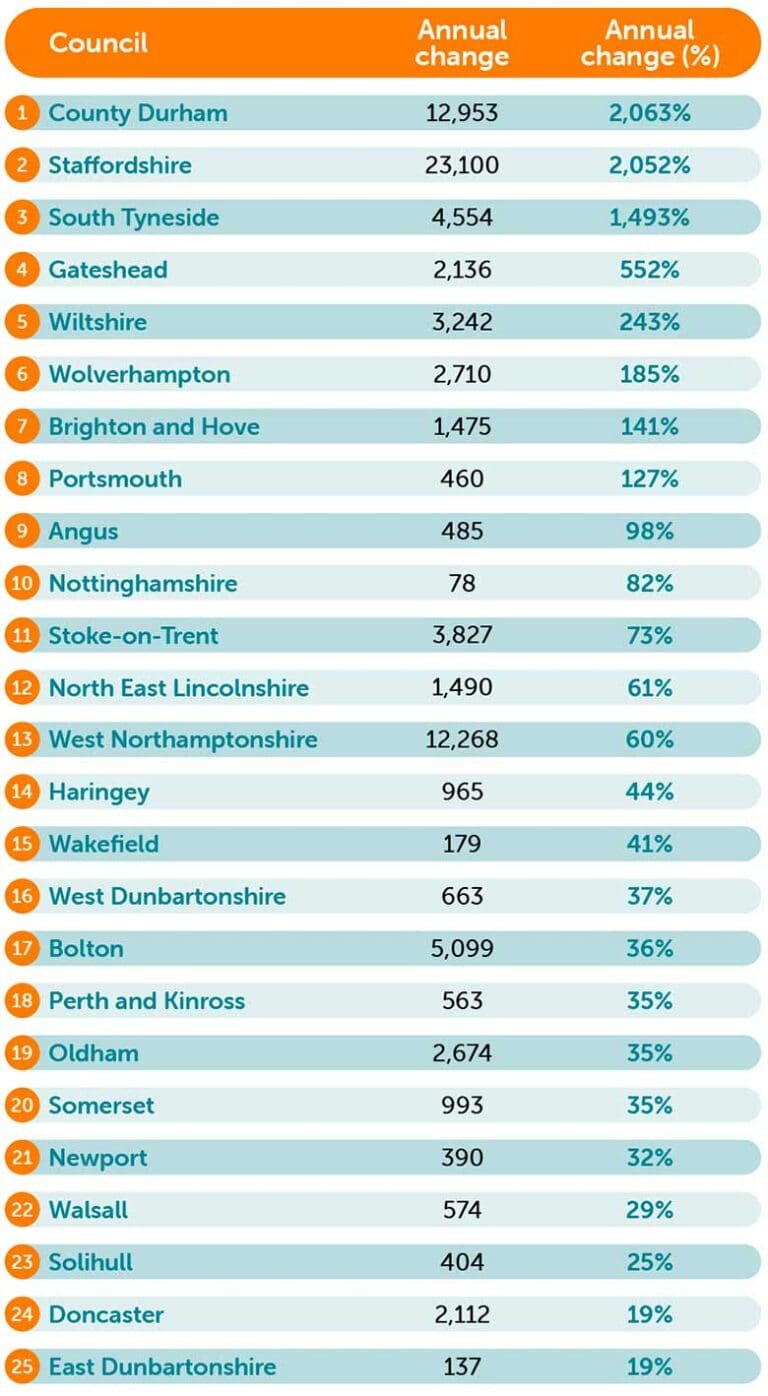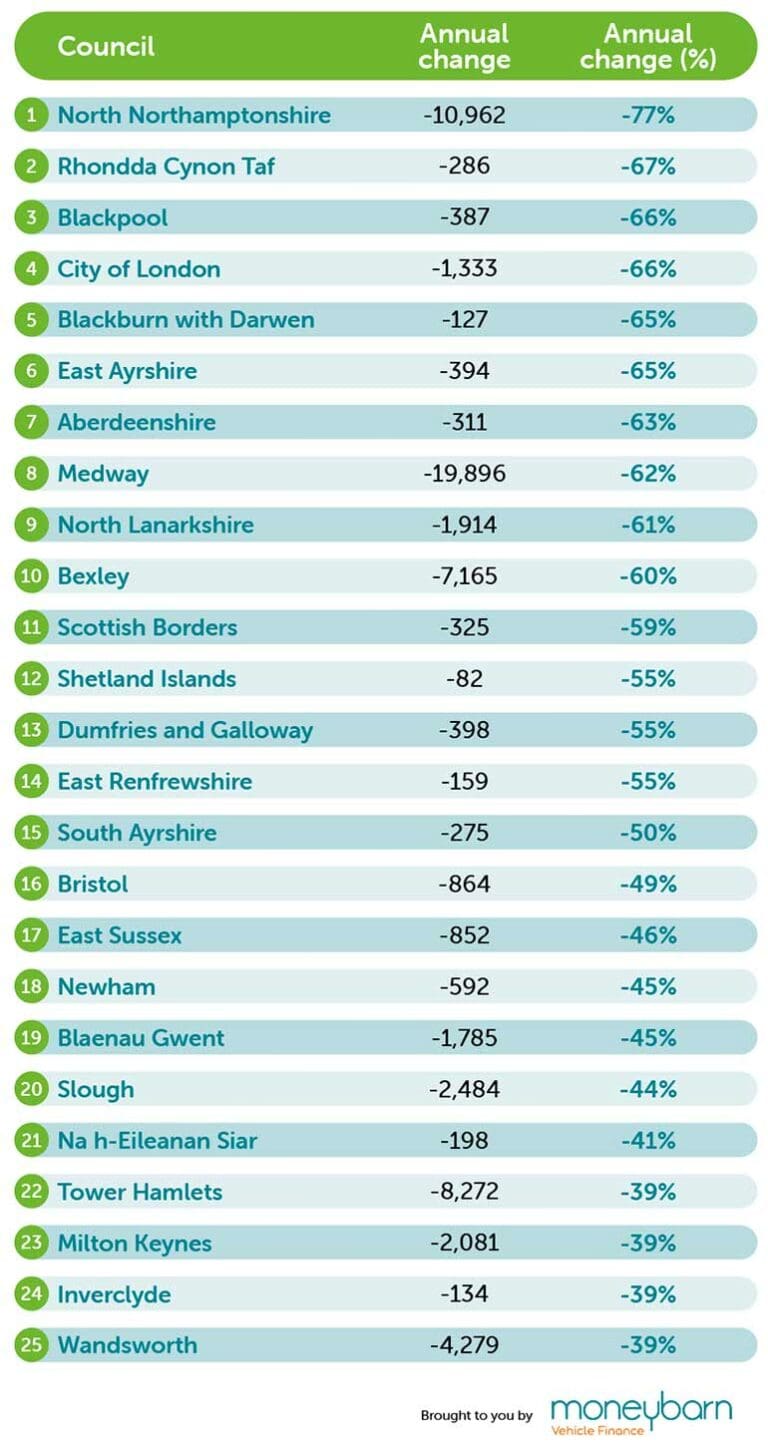- Car finance Car finance
- Motorbike finance Motorbike finance
- Van finance Van finance
- How it works How it works
- FAQs and guides FAQs and guides
- About us About us
- Home
- Blog
- Latest Motor News
- Roadwork Capitals
Roadwork Capitals
Updated: Wednesday, 7 September 2022


Roadworks play a vital role in maintaining the infrastructure of the country by making sure traffic can run smoothly and safely throughout the land.
Nevertheless, they can still be a massive source of frustration to road users as they can cause lengthy delays and disruption to a vast number of people.
It can cost a lot of money to buy a car or have car finance, and unfortunately due to roadworks, it is often not a smooth drive into the sunset once you’re on the road.
On average it is estimated that UK motorists lose 28 hours a year due to being stuck in traffic caused by roadworks, and almost everyone in the country has been impacted by them at some point.
Even small works in the UK can feel like they take an eternity compared to other countries.
For example, in 2016 a major road in the Japanese city of Fukuoka was completely destroyed by a massive 15-meter deep sinkhole, this was completely repaired and reopened in six days.
Meanwhile, it is very hard to find a town in Britain that is not littered with long term potholes as there were 1.1 million of them recorded in 2016.
Not all areas of the country have the same level of roadworks, and to determine where in the country is best for uninterrupted drives we have launched an in-depth data-driven study into the areas with the most frequent and recent incidents of road and street works. By sending Freedom of Information requests to local authorities around the country, the roadwork capitals of the UK have been revealed.
Top Three Roadwork Capitals
Roadworks play a vital role in maintaining the infrastructure of the country by making sure traffic can run smoothly and safely throughout the land.
Nevertheless, they can still be a massive source of frustration to road users as they can cause lengthy delays and disruption to a vast number of people.
It can cost a lot of money to buy a car or have car finance, and unfortunately due to roadworks, it is often not a smooth drive into the sunset once you’re on the road.
On average it is estimated that UK motorists lose 28 hours a year due to being stuck in traffic caused by roadworks, and almost everyone in the country has been impacted by them at some point.
Even small works in the UK can feel like they take an eternity compared to other countries.
For example, in 2016 a major road in the Japanese city of Fukuoka was completely destroyed by a massive 15-meter deep sinkhole, this was completely repaired and reopened in six days.
Meanwhile, it is very hard to find a town in Britain that is not littered with long term potholes as there were 1.1 million of them recorded in 2016.
Not all areas of the country have the same level of roadworks, and to determine where in the country is best for uninterrupted drives we have launched an in-depth data-driven study into the areas with the most frequent and recent incidents of road and street works. By sending Freedom of Information requests to local authorities around the country, the roadwork capitals of the UK have been revealed.
Top Three Roadwork Capitals
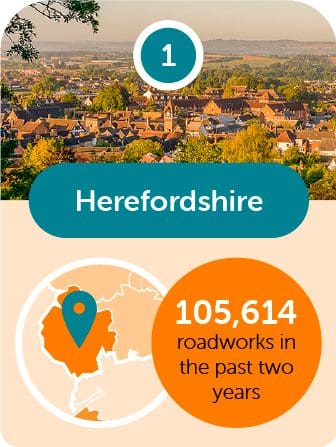
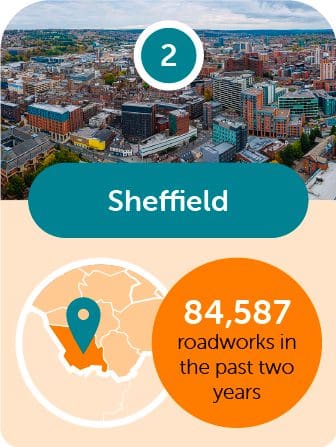
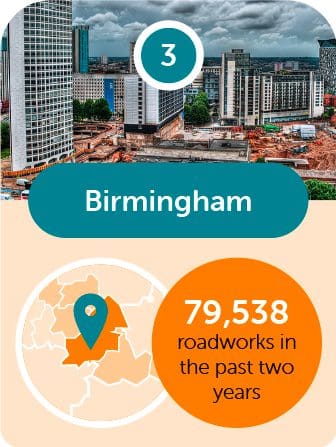



1. Herefordshire: 105,614 roadworks in the past two years
The west English county of Herefordshire has seen the most road and street works undertaken in the past two years by the council and utilities. With over 100,00 it is the only council area of any type in the country with a six-figure number of roadwork projects. Furthermore, it is almost 90,000 more than the national average for the same period.
2. Sheffield: 84,587 roadworks in the past two years
Sheffield had just under 85,000 separate roadworks in the past two years which makes it the roadwork capital city of the country. Within the city council boundaries of the Steel City, there were 44,677 roadworks in 2020/21, the longest of which took 19 days to complete. This is slightly higher than in 2019/20 when 39,910 works were carried out.
3. Birmingham: 79,538 roadworks in the past two years
Birmingham is the largest city council area with a population of almost 1 million more people than Sheffield, however, when it comes to roadworks there were 5,049 fewer roadworks in the second city over the past two years. This is largely due to a 36% decrease in the number of roadworks taking place in Birmingham in 2020/21 than there had been the previous year.
Top three areas with least amount of roadworks
1. Herefordshire: 105,614 roadworks in the past two years
The west English county of Herefordshire has seen the most road and street works undertaken in the past two years by the council and utilities. With over 100,00 it is the only council area of any type in the country with a six-figure number of roadwork projects. Furthermore, it is almost 90,000 more than the national average for the same period.
2. Sheffield: 84,587 roadworks in the past two years
Sheffield had just under 85,000 separate roadworks in the past two years which makes it the roadwork capital city of the country. Within the city council boundaries of the Steel City, there were 44,677 roadworks in 2020/21, the longest of which took 19 days to complete. This is slightly higher than in 2019/20 when 39,910 works were carried out.
3. Birmingham: 79,538 roadworks in the past two years
Birmingham is the largest city council area with a population of almost 1 million more people than Sheffield, however, when it comes to roadworks there were 5,049 fewer roadworks in the second city over the past two years. This is largely due to a 36% decrease in the number of roadworks taking place in Birmingham in 2020/21 than there had been the previous year.
Top three areas with least amount of roadworks
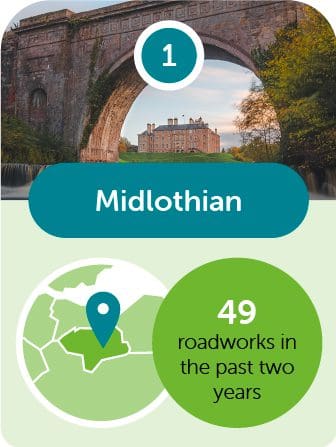
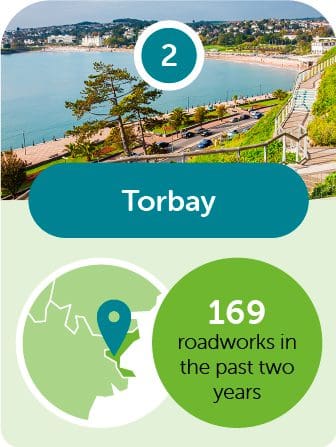
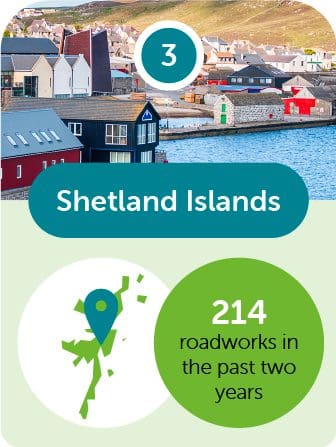



1. Midlothian: 49 roadworks in the past two years
The area of the UK with the fewest number of roadworks over the past two years is Midlothian in Scotland, which covers an area from south Edinburgh to the Borders. Incredibly there were only 49 recorded road and street works in the period, which is only 0.05% of the number of roadworks in Herefordshire.
2. Torbay: 169 roadworks in the past two years
Torbay is a small council area on the south coast of Devon in South West England, where driving is clearly stress-free for the seasiders as there were only 169 recorded roadworks in the past two years. The longest of these works lasted 86 days at Babbacombe Road for resurfacing.
3. Shetland Islands: 214 roadworks in the past two years
From one end of the country to the other, the Shetlands are the most northern point of the UK, 110 miles from the top of the mainland. In the past two years, Shetlanders have been able to enjoy pleasant driving as there have only been 214 separate roadworks in place across the island.
Areas with the biggest increase in roadworks in the past year
1. Midlothian: 49 roadworks in the past two years
The area of the UK with the fewest number of roadworks over the past two years is Midlothian in Scotland, which covers an area from south Edinburgh to the Borders. Incredibly there were only 49 recorded road and street works in the period, which is only 0.05% of the number of roadworks in Herefordshire.
2. Torbay: 169 roadworks in the past two years
Torbay is a small council area on the south coast of Devon in South West England, where driving is clearly stress-free for the seasiders as there were only 169 recorded roadworks in the past two years. The longest of these works lasted 86 days at Babbacombe Road for resurfacing.
3. Shetland Islands: 214 roadworks in the past two years
From one end of the country to the other, the Shetlands are the most northern point of the UK, 110 miles from the top of the mainland. In the past two years, Shetlanders have been able to enjoy pleasant driving as there have only been 214 separate roadworks in place across the island.
Areas with the biggest increase in roadworks in the past year
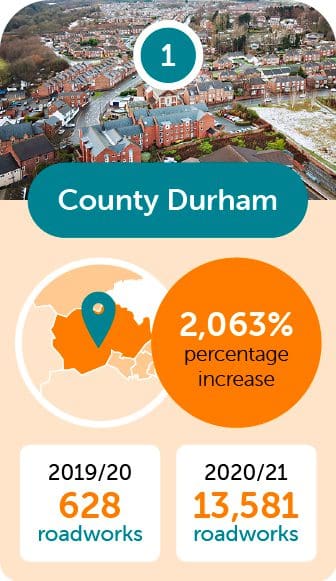
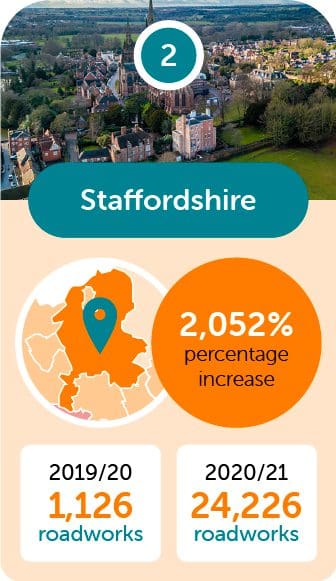
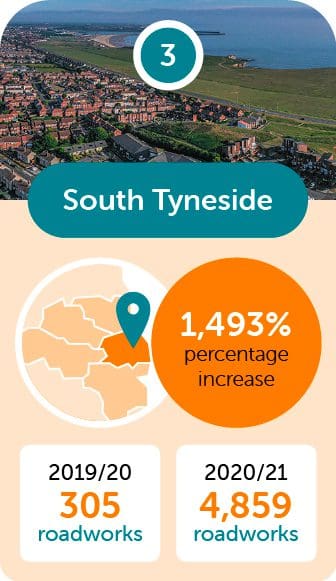



1. County Durham: 2063% increase
2019/20 – 628 roadworks
2020/21 – 13,581 roadworks
In County Durham, there has been an astronomical rise in the number of roadworks in the past year, as the total number shot up by almost 13,000. According to Durham County Council, this is due to the coronavirus pandemic delaying a large number of works so they did not begin until 2020/21.
2. Staffordshire: 2052% increase
2019/20 – 1,126 roadworks
2020/21 – 24,226 roadworks
Staffordshire has the second-highest increase in the number of recorded roadworks, in 2019/20 there was just over 1,000, whereas in 2020/21 there were almost 25,000 road and street works recorded by the council.
3. South Tyneside: 1493% increase
2019/20 – 305
2020/21 – 4,859
One of the longest ongoing works on South Tyneside were bridge repairs that are scheduled to take eight months. Along with this are an extra 4,554 more roadworks than in the previous year.
Areas with the biggest decrease in roadworks in the past year
1. County Durham: 2063% increase
2019/20 – 628 roadworks
2020/21 – 13,581 roadworks
In County Durham, there has been an astronomical rise in the number of roadworks in the past year, as the total number shot up by almost 13,000. According to Durham County Council, this is due to the coronavirus pandemic delaying a large number of works so they did not begin until 2020/21.
2. Staffordshire: 2052% increase
2019/20 – 1,126 roadworks
2020/21 – 24,226 roadworks
Staffordshire has the second-highest increase in the number of recorded roadworks, in 2019/20 there was just over 1,000, whereas in 2020/21 there were almost 25,000 road and street works recorded by the council.
3. South Tyneside: 1493% increase
2019/20 – 305
2020/21 – 4,859
One of the longest ongoing works on South Tyneside were bridge repairs that are scheduled to take eight months. Along with this are an extra 4,554 more roadworks than in the previous year.
Areas with the biggest decrease in roadworks in the past year
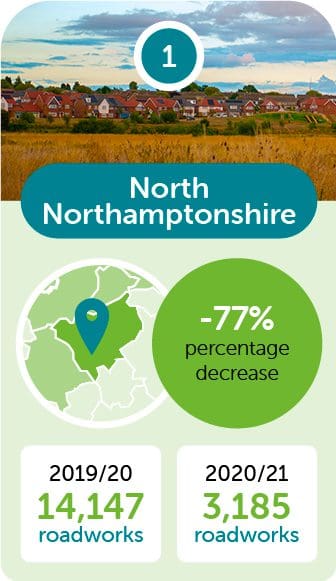
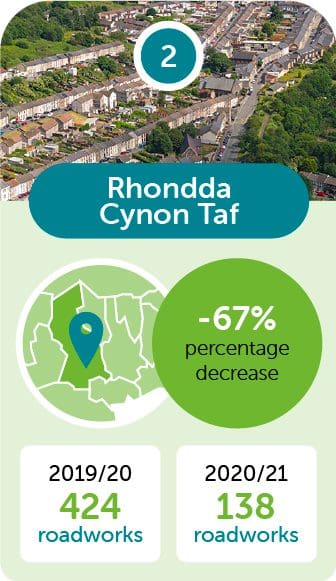
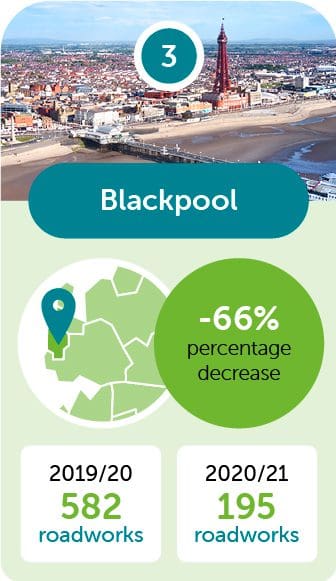



1. North Northamptonshire: 77% decrease
2019/20 – 14,147
2020/21 – 3,185
The biggest decrease in the number of roadworks occurred in north Northamptonshire, therefore residents have had the biggest easing of roadwork related driving problems anywhere in the country.
2. Rhondda Cynon Taf: 67% decrease
2019/20 – 424
2020/21 – 138
The South Wales area of Rhondda Cynon Taf has seen the second-biggest decrease in the number of roadworks from 2019/20 to 2020/21. Two years ago there were 424 separate roadworks, decreasing by 67% to 138 in the last year.
3: Blackpool: 66% decrease
2019/20 – 582
2020/21 – 195
The only thing dropping faster than those riding the ‘Big One’ in Blackpool is the frequency of roadworks in the coastal Lancashire town. There was a 66% decrease from 582 separate roadworks in 2019/20 to 195 in 2020/21.
Methodology
- All the data was collected by sending FOIs to councils across the UK requesting: “Under the Freedom of Information Act, I would like to request the number of street works and road works carried out by the council for both the 2019/20 and 2020/21 financial years. If possible, I would also like to know the longest-running works that took place in both of these periods.”
- Out of 395 councils that the request was sent to, 244 did not respond, declined the request, or sent unusable data.
- This left 151 councils that were ranked by the total number of roadworks over the past two years.
- We then calculated the difference between the number of roadworks in both 2019/20 and 2020/21.
1. North Northamptonshire: 77% decrease
2019/20 – 14,147
2020/21 – 3,185
The biggest decrease in the number of roadworks occurred in north Northamptonshire, therefore residents have had the biggest easing of roadwork related driving problems anywhere in the country.
2. Rhondda Cynon Taf: 67% decrease
2019/20 – 424
2020/21 – 138
The South Wales area of Rhondda Cynon Taf has seen the second-biggest decrease in the number of roadworks from 2019/20 to 2020/21. Two years ago there were 424 separate roadworks, decreasing by 67% to 138 in the last year.
3: Blackpool: 66% decrease
2019/20 – 582
2020/21 – 195
The only thing dropping faster than those riding the ‘Big One’ in Blackpool is the frequency of roadworks in the coastal Lancashire town. There was a 66% decrease from 582 separate roadworks in 2019/20 to 195 in 2020/21.
Methodology
- All the data was collected by sending FOIs to councils across the UK requesting: “Under the Freedom of Information Act, I would like to request the number of street works and road works carried out by the council for both the 2019/20 and 2020/21 financial years. If possible, I would also like to know the longest-running works that took place in both of these periods.”
- Out of 395 councils that the request was sent to, 244 did not respond, declined the request, or sent unusable data.
- This left 151 councils that were ranked by the total number of roadworks over the past two years.
- We then calculated the difference between the number of roadworks in both 2019/20 and 2020/21.
Bringing you the latest news and insights from Moneybarn.
More from Moneybarn...
For a better road ahead
Moneybarn is a member of the Finance and Leasing Association, the official trade organisation of the motor finance industry. The FLA promotes best practice in the motor finance industry for lending and leasing to consumers and businesses.
Moneybarn is the trading style of Moneybarn No. 1 Limited, a company registered in England and Wales with company number 04496573, and Moneybarn Limited, a company registered in England and Wales with company number 02766324. The registered address for these companies is: Athena House, Bedford Road, Petersfield, Hampshire, GU32 3LJ.
Moneybarn’s VAT registration number is 180 5559 52.
Moneybarn Limited is authorised and regulated by the Financial Conduct Authority (Financial Services reference No. 702781)
Moneybarn No. 1 Limited is authorised and regulated by the Financial Conduct Authority (Financial Services reference No. 702780)





